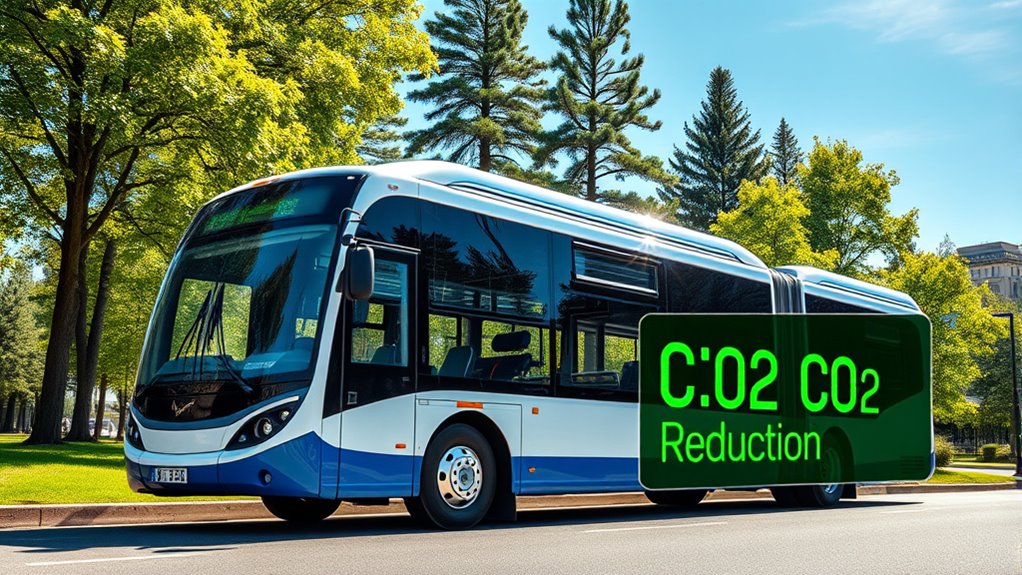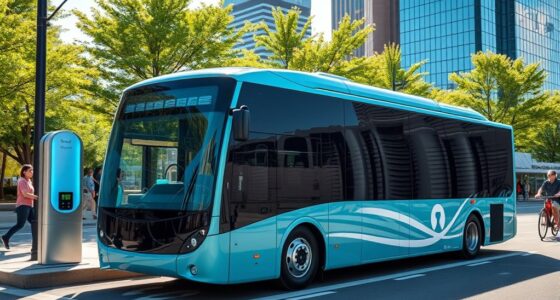Switching from diesel to renewable-powered electric buses can slash about 1.8 kilograms of CO₂ emissions per mile, making a significant impact on your community’s greenhouse gas footprint. Each bus replaced with an electric model powered by clean energy helps reduce emissions, supporting climate goals and improving local air quality. Over time, these small changes add up to substantial environmental benefits. Keep exploring to discover how such shifts can lead to deeper sustainability advancements.
Key Takeaways
- Replacing a diesel bus with a renewable-powered electric bus can eliminate approximately 1.8 kg of CO₂ per mile traveled.
- Transitioning to renewable energy for bus fleets significantly reduces daily and cumulative greenhouse gas emissions.
- Each electric bus contributes to local emission reductions, supporting community efforts to combat climate change.
- Switching from conventional fuels to renewable energy sources decreases emissions from energy extraction and combustion processes.
- Long-term deployment of renewable-powered buses results in substantial reductions in overall community carbon footprints.

Have you ever wondered how small changes can make a big difference in reducing greenhouse gases? One effective way is by looking at the impact of buses and how their fuel choices influence overall emissions. Moving to cleaner energy sources isn’t just a trend; it’s a crucial emission reduction strategy that can considerably lower greenhouse gases like CO₂. When you think about public transportation, switching from traditional diesel buses to those powered by renewable energy sources can drastically cut the carbon footprint per vehicle. These changes aren’t just about technology; they’re about making smarter choices that benefit the environment and your community.
Small changes, like switching to renewable-powered buses, can significantly reduce your community’s carbon footprint.
By integrating renewable energy into bus operations, you directly target the root of many emission problems. Electric buses charged with solar, wind, or other renewable sources emit zero tailpipe emissions, which means a tangible reduction in greenhouse gases. For each bus shifted from conventional fuel to renewable-powered electric models, the CO₂ savings can be substantial. For example, a typical diesel bus releases around 1.8 kilograms of CO₂ per mile. Replacing it with an electric bus powered by renewable energy can eliminate those emissions, leading to hundreds of kilograms saved daily, depending on the route length. Over time, these savings add up, contributing considerably to local and national emission reduction goals.
Not only does switching to renewable energy improve air quality, but it also demonstrates a proactive approach to climate change mitigation. It’s a practical application of emission reduction strategies that you can support or advocate for in your community. Many cities are now investing in renewable energy infrastructure and electric bus fleets to meet environmental targets. These efforts showcase how small, strategic changes—like choosing buses that run on renewable energy—can have a ripple effect, inspiring other sectors to follow suit. Such initiatives also reduce dependence on fossil fuels, further decreasing greenhouse gases associated with energy extraction and combustion. Additionally, embracing renewable energy sources enhances energy independence, making communities more resilient to global fuel market fluctuations.
In addition, adopting renewable energy for transportation aligns with broader sustainable development goals. It encourages innovation, creates green jobs, and promotes energy independence. When you consider the overall impact, each bus powered by renewable energy contributes to a cleaner, healthier environment. The cumulative effect of many buses making this switch can lead to measurable reductions in CO₂ emissions, making a real difference in your community’s carbon footprint. So, by supporting or embracing these emission reduction strategies, you’re participating in a crucial movement toward a more sustainable future—one bus at a time.
Frequently Asked Questions
How Do Bus Emissions Compare to Car Emissions per Passenger?
You’ll find bus emissions are generally lower per passenger than cars because of fleet efficiency and stricter emission standards. Buses carry more people, spreading out the emissions they produce, which reduces overall pollution per passenger. Compared to cars, buses are a more sustainable option, helping you cut your carbon footprint. By choosing buses, you support cleaner transportation and help meet emission standards aimed at reducing greenhouse gases.
What Are the Long-Term Benefits of Reducing Bus Co₂ Emissions?
Reducing bus CO₂ emissions benefits urban planning and public health over the long term. When you cut emissions, you improve air quality, reducing respiratory issues and diseases. It also encourages sustainable transportation, easing traffic congestion and making cities more livable. These efforts support healthier communities and promote environmentally friendly growth. By prioritizing emission reductions, you help create urban environments that are safer, cleaner, and more conducive to a better quality of life.
How Do Electric Buses Impact Greenhouse Gas Savings?
Imagine electric buses as clean, shining beacons guiding your community toward a greener future. They considerably boost greenhouse gas savings by reducing emissions along the entire emission lifecycle. With improved battery efficiency, these buses use less energy, cutting CO₂ output and lowering your carbon footprint. As a result, you help combat climate change and promote sustainability, making your transportation choices impactful for generations to come.
What Role Do Renewable Energy Sources Play in Bus Emissions?
Renewable energy sources substantially reduce bus emissions by enabling renewable integration into the grid. When your local grid adopts more renewables, such as wind or solar, it becomes cleaner, which means electric buses powered by this energy produce fewer greenhouse gases. This process supports grid decarbonization, making your transportation more sustainable and helping you contribute to lowering overall carbon footprints. You play a part in a greener future by choosing cleaner energy options.
Are There Specific Regions With Higher Greenhouse Gas Reductions From Buses?
You’ll find that regions with strong regional policies and high urban density tend to have higher greenhouse gas reductions from buses. These policies promote cleaner technologies and efficient routes, while dense urban areas reduce travel distances and improve bus utilization. By focusing on these regions, you can maximize CO₂ savings, as buses operate more sustainably where supportive policies are in place and urban environments encourage public transportation use.
Conclusion
By choosing public buses over personal vehicles, you can reduce your carbon footprint considerably. For example, riding a bus can save approximately 33 pounds of CO₂ emissions daily. Imagine the collective impact if more people made this switch—millions of tons of greenhouse gases could be cut annually. Every trip taken on a bus not only gets you where you need to go but also helps protect our planet’s future. Your choice truly makes a difference.








